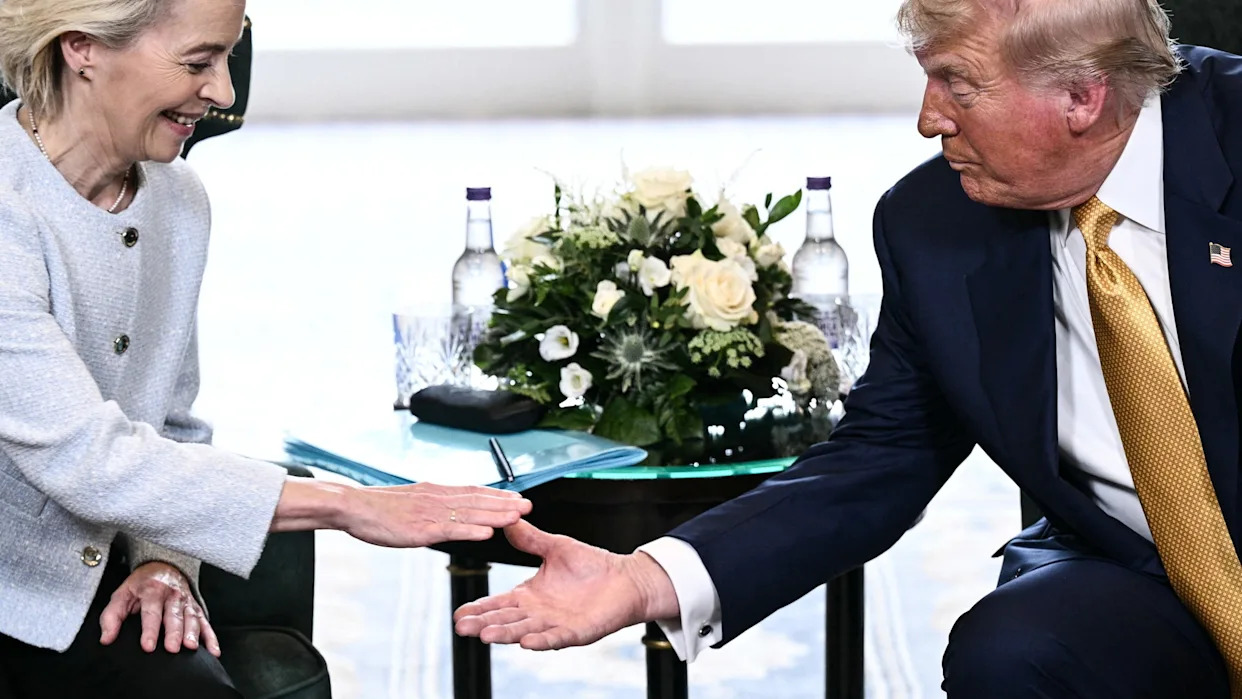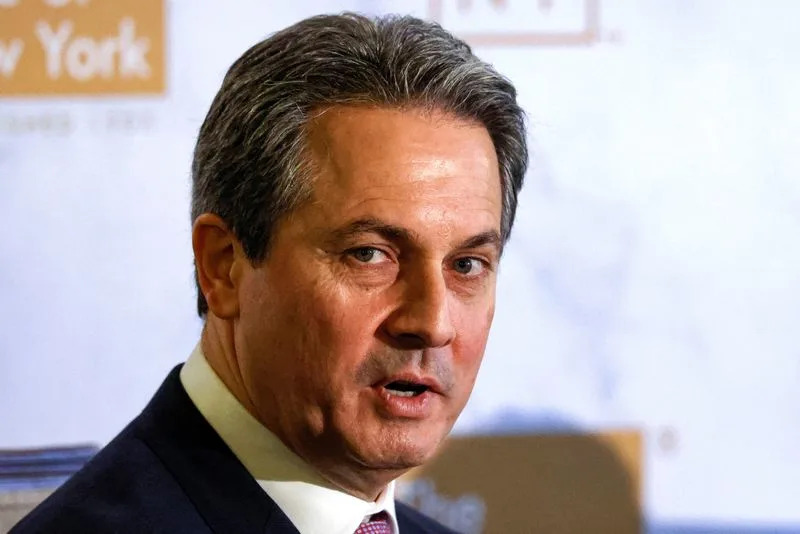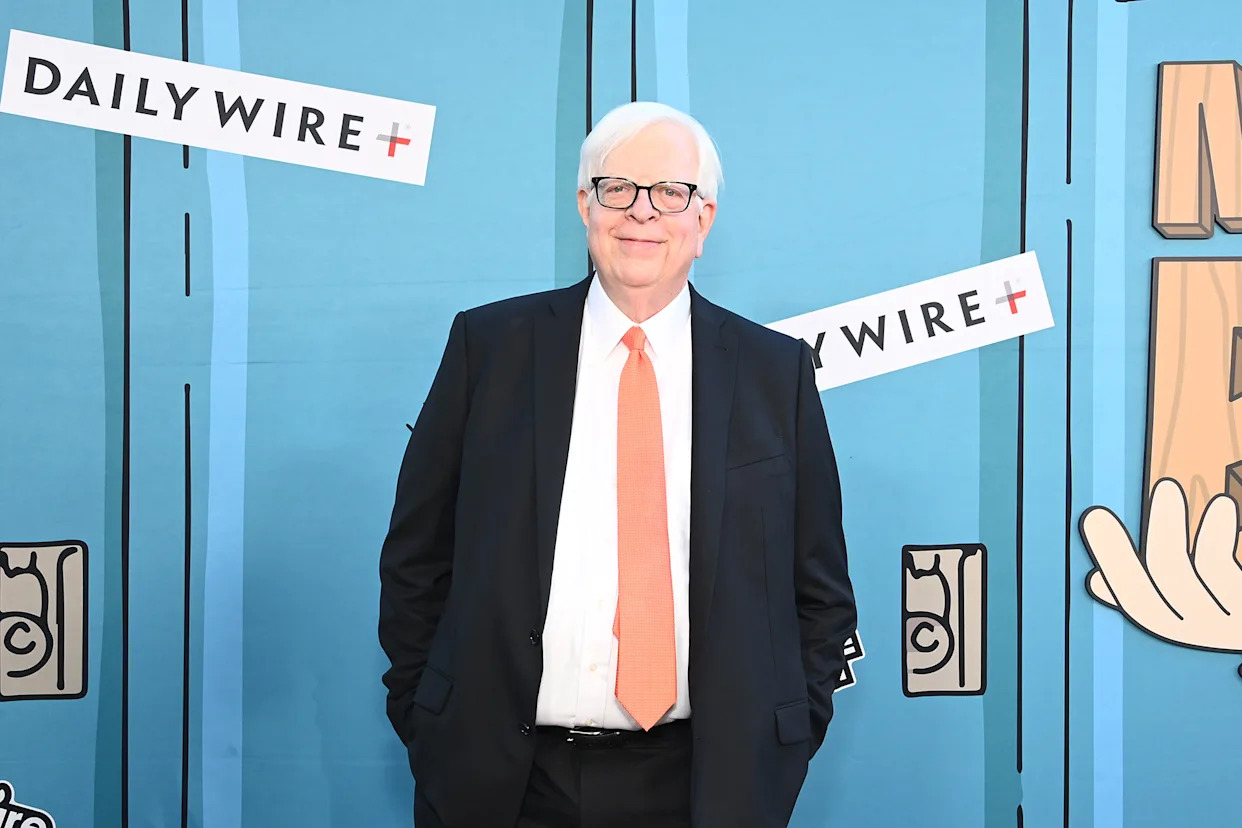
The Atlantic Daily, a newsletter that guides you through the biggest stories of the day, helps you discover new ideas, and recommends the best in culture. Sign up for it here.
If there’s anything Donald Trump loves more than tariffs, it’s a deal. So you can understand his excitement lately. Over the past few weeks, the president has announced tariff-related deals with three major trading partners—the European Union, Japan, and South Korea—that have been hailed as major victories for the United States. In each case, America’s partners agreed to accept 15 percent tariffs on their exports to the U.S. while lowering trade barriers on American goods and promising to invest hundreds of billions of dollars in the U.S. economy—in essence paying Trump to impose trade restrictions on them. “Europe Caves to Trump on Tariffs” read a representative New York Times headline.
In the days following the European Union deal announcement, the White House released a fact sheet quoting all the positive coverage. On Thursday, Jamieson Greer, Trump’s top trade official, published a New York Times op-ed boasting that, with the completion of these deals, the administration had successfully “remade the global order.” But upon closer inspection, Trump’s trade deals aren’t nearly as impressive as they sound. In fact, they aren’t really trade deals in the traditional sense, and they might not benefit the U.S. at all.
Trump did prove the doubters wrong in one important way. When the president originally announced his “Liberation Day” tariffs, other countries threatened to respond in kind, leading many economists and journalists (myself included) to conclude that the tariffs would lead to a spiral of retaliation. With a few exceptions (notably China and Canada), that didn’t happen. Instead, Trump has gotten key trading partners to back down.
But simply avoiding retribution was never the goal of tariffs. The whole point of Trump’s dealmaking strategy was supposedly to get foreign countries to lower their existing trade barriers—the classic purpose of a trade agreement. In his Liberation Day announcement, Trump complained at length about what he considered to be the excessive restrictions that other countries had imposed on American goods—including not only tariffs but also currency manipulation, value-added taxes, and subsidies to domestic firms—and vowed not to back down on tariffs until those countries lowered them.
[Scott Lincicome: What the U.K. deal reveals about Trump’s trade strategy]
The announcements of the new deals purport to have delivered on this promise, giving Americans “unprecedented levels of market access” to Europe, “breaking open long-closed markets” in Japan, and making South Korea “completely OPEN TO TRADE with the United States.” But the details of the deals, which remain sparse, tell a very different story. None include agreements by trading partners to meaningfully reform their tax or regulatory codes, strengthen their currencies, or reduce the barriers that have long been major sticking points in prior trade negotiations. Instead, the announcements are full of vague statements of intent—“The United States and the European Union intend to work together to address non-tariff barriers affecting trade in food and agricultural products” (my emphasis)—and references to things such as “openings for a range of industrial and consumer goods.”
The main concrete action that the EU agreed to was to eliminate its tariffs on American industrial products. This sounds impressive unless you’re aware that the average EU tariff rate on nonagricultural goods prior to the deal was just 1 percent. The main difficulty in trade negotiations with the EU has long been its barriers on agricultural products, which appear to have been untouched by these deals. South Korea and Japan, meanwhile, agreed to allow more American-made cars into their markets—which also sounds great until you realize that the main reason American companies don’t sell a lot of cars to those countries is the fact that almost nobody wants to drive a truck or SUV in Tokyo or Seoul. Lower trade barriers won’t change that.
What about the investments? According to the announcements, South Korea, Japan, and Europe have respectively pledged to invest $350 billion, $550 billion, and $600 billion in the United States (In an interview with CNBC, referring to the EU investment, Trump claimed that “the details are $600 billion to invest in anything I want. Anything. I can do anything I want with it.”) The EU has also agreed to purchase an additional $750 billion of American oil and gas. Those are big numbers, but they might not add up to much in the real world. The EU has no authority to require European companies to invest in the U.S. or buy its products. What the Trump administration touted as “commitments” were mostly rough numbers based on what European companies were already planning to invest and buy. “We can’t force the company to do anything, nor will be able to pretend that we can, but we can talk to them, we can get their intentions, and we can transmit that as a faithful indication to our partners in the U.S.,” Olof Gill, a spokesperson for the European Commission, the EU’s trade-negotiation body, said after the deal was announced.
The “investments” from Japan and South Korea, meanwhile, might not be investments at all. Shortly after the deal with Japan was announced, the country’s top trade negotiator said that he anticipated only 1 or 2 percent of the $550 billion fund would come in the form of direct investment; the rest would mostly consist of loans that would need to be repaid with interest. South Korean officials have made similar statements. “These numbers bear no relation to any conception of reality,” Brad Setser, a senior fellow at the Council on Foreign Relations who served as a trade adviser to the Biden administration, told me. “Everyone has figured out that Trump really likes big numbers to sell his trade deals and doesn’t need much substance to do so.” Recent history supports this view. As part of Trump’s first-term trade deal with China, Beijing agreed to increase its annual purchasing of American goods by $200 billion. In the event, it didn’t increase its purchasing at all.
If America’s trading partners didn’t agree to meaningfully lower barriers to U.S. imports, and if their promises of investment are likely vaporous, then the only real concession that Trump’s tariffs have won is … the right to impose tariffs. This means that the value of the deals comes down to the value of the tariffs.
Tariffs can help domestic producers by making their foreign competitors’ products more expensive. But tariffs can also hurt them, by raising the costs of the inputs they import to make their products. Several studies of the tariffs imposed during Trump’s first term, which were much smaller and more targeted, found that manufacturing employment either stayed level or actually fell as a result. The ultimate result of the current wave of tariffs is yet to be determined, but so far, since Liberation Day, the manufacturing sector has shed tens of thousands of jobs and investment in new factories has fallen. A quarterly survey conducted by the National Association of Manufacturers in May found that optimism among manufacturing firms had fallen to its lowest point since the height of the coronavirus pandemic; trade uncertainty and raw-material costs were cited as top concerns.
[Rogé Karma: The mystery of the strong economy has finally been solved]
The new deals should at least give companies some much-needed certainty about tariff rates, which will help them make investment decisions. But in other ways, the deals actively undermine key American industries. Foreign cars, which represent the single largest American import from Japan and South Korea and the third largest from the EU, will face 15 percent tariffs. That is far lower than the rate American car companies have to pay to import car parts, which are tariffed at 25 percent, and crucial car-building materials like steel and aluminum, which are tariffed at 50 percent. As Jim Farley, the CEO of Ford, said in a recent interview, foreign competitors such as Toyota now have a $5,000 to $10,000 cost advantage over American-made vehicles. Ford projects that it will lose $2 billion in profits this year alone because of higher tariffs; General Motors forecasts losses of $4 billion to $5 billion by the end of the year.
The deals announced so far are only the beginning. The Trump administration is currently in the midst of negotiations with several trading partners, including China, Mexico, Switzerland, and Taiwan, and just yesterday implemented a new round of tariffs on about 90 countries, the ostensible goal being to bring those nations to the bargaining table too. If recent events are an indication, any future pacts will be framed as historic milestones in the quest to remake the global trade system in America’s favor. The White House will issue pronouncements of eye-popping investments, drastically reduced foreign-trade barriers, and major concessions to American industry. When that happens, remember to look closely at the details.








Comments